Best 12v Inverter For Camper Van Conversion Or RV
Many electronics like a laptop or TV are impossible to power directly from your camper van batteries. Inverters to the rescue! Inverters are cool devices that turn 12 volt battery power into 110V or 220V AC power.
- Do you own an RV? Read our post on converters, inverters and inverter chargers
- 1000W pure sign inverter
- Peak surge of 2000W
- Digital display that indicates battery capacity, output voltage and DC indicator
- Peak surge of 800W with 400W of continuous power
- Safety features such as overload, overheat and low battery protection
- Comes with just two household AC plugs and one USB port
- 300W multi-step unit
- Continuous power surge of 300W with a peak of 700W
- Two AC plugs and two USB ports to charge up to four devices at once
Do You Need A 12V Inverter?
Inverters are common for camper conversions but they are not necessary for every build. If you can get away with powering everything straight from a DC battery, then skip the inefficiency and save some money. For those trying to cook with and induction burner or run a high powered laptop, you might not have a choice.
DC Electrics commonly come with a USB plug
AC Electronics use a two or three prong household wall socket
When trying to power AC household electronics: chances are, you need an inverter.
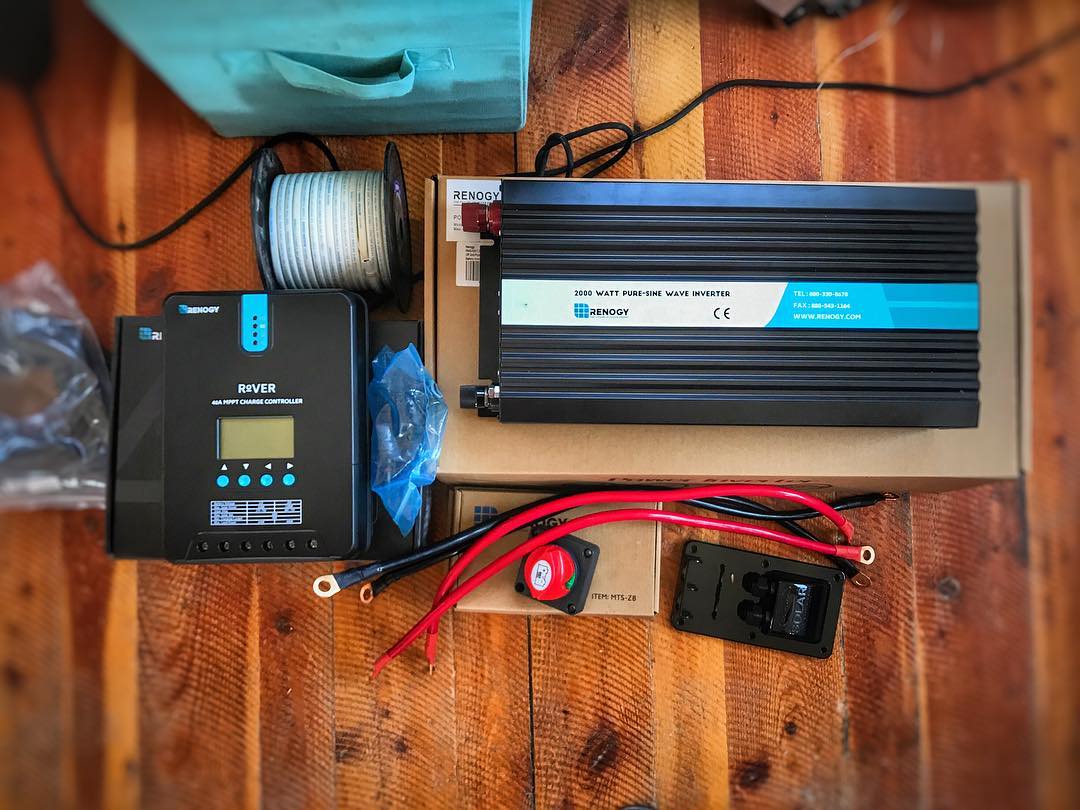
What Type of 12v Inverter to Get
There are only two things you will be deciding on when looking at inverters: Size and Type
There are two main types of inverters- MSW and PSW. Alternating current travels in waves that “alternate” from (+) to (-). This is different from how direct current power travels through circuits. These two inverter types describe how DC power is converted into AC power. A picture makes this easier:
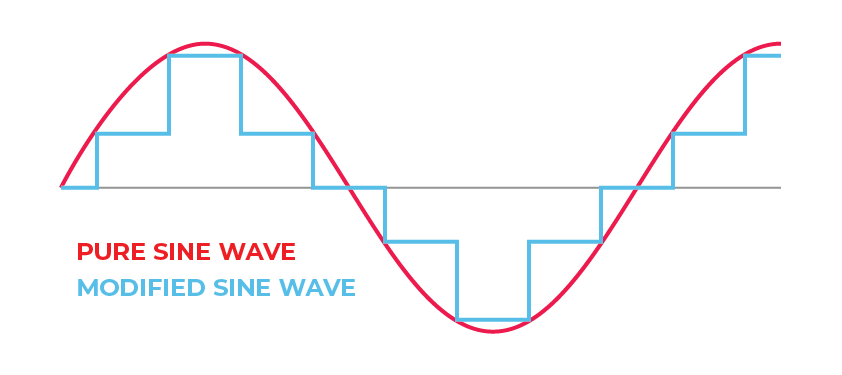
- Modified Sine Wave (MSW): More accurately called a multi-step wave inverter. These inverters are less expensive as they aren’t as complex. They create a “choppy” approximation of a sine wave. For many electrical components, it makes little difference how the wave looks, such as light bulbs or things with electric motors like compressors and power tools. Other electrical devices such as electric blankets, coffee makers and induction burners won’t work very well because their microprocessors need a clean wave to regulate temperature properly. MSW inverters also create a “buzzing” noise when operating certain devices.
- Pure Sine Wave (PSW): These have a higher up-front cost due to the electrical complexity. There are no limitations as to what AC devices you can plug into them, other than trying to use more power than the inverter can deliver. They are also slightly more efficient, and we recommend this option if you have the means.
What Size of Inverter to Get
Here’s where we see people go astray. There are limits on sizing an inverter. It’s no surprise that you don’t want it to be too small because then you won’t get enough power. But there are also issues with going too big.
Inverters come sized by how many Watts they can output. Most are listed in continuous watts and peak (or surge) watts.
- Continuous Watts: This is the listed inverter size, and the size you base your measurements on. It is the amount of watts that the inverter can output in normal use.
- Peak (or surge) Watts: This is the max output that the inverter can handle for a short period of time. It won’t affect too many calculations in a van build. The purpose is that many devices have a “start” load that is significantly higher than their running load. For instance, a fridge compressor may draw 100W when it kicks on, but settle down to a steady 50W after a couple of seconds.
The first task is to figure out the maximum amount of watts that you’ll be using at one time. This usually means that you’ll add up all the devices that will be plugged in at once. Sometimes you will have devices that won’t ever be used together (AC and electric blanket) so pick the larger of the two. Then pick an inverter that is rated at a comfortable size above that load (120% or so)
Here is an example:
| Component | Watts |
|---|---|
| Laptop | 90W |
| Fan | 10W |
| Electric Blanket | 170W |
| Total | 270W |
In this case, if all of the AC powered items are plugged in at one time, you’ll be drawing 270 watts. A 300W inverter will do the job, but a 400W inverter will be ideal. Which brings up the natural follow up question,
Why not go even bigger?
- Efficiency. Smaller inverters are more efficient at smaller loads and at idle. Notice the big aluminum fins on inverters? Those are to bleed off excess heat; lost heat is lost power. So if you are powering a 90W laptop with a 1000W inverter, it will be using slightly more power than doing the same with a 400W inverter.
- Cost. While this isn’t a technical problem, when you get into some better quality PSW inverters, cost can add up quickly with no real benefit.

Now that you know your ideal inverter size, you need to check that your batteries are capable of powering it.
This is a big issue, and one that many campers don’t account for. It is harmful on the battery to discharge it too quickly. Batteries can’t let go of all of their energy at once. In most cases, it will shorten the lifespan of the battery but sometimes you completely ruin your battery. The sizing for this is directly related to the size and type of your batteries, which we explain in more detail in the charging section of our batteries article.
For right now, you can be that your inverter isn’t over the max size with this rule of thumb:
Maximum inverter size =
1.5W for every Ah of an FLA battery
3W for every Ah of an AGM battery
6W for every Ah of a Lithium battery
If you have a basic 150Ah FLA deep cycle battery bank, your safe inverter size is 225 Watts (150 x 1.5).
This can open up a can of worms. You might quickly notice that most vandwellers use a massively oversized inverter for their setup. If you end up calculating that you need 1200W but your batteries should only discharge 400W, you have a sizing mismatch. This doesn’t really have anything to do with your inverter, but it means that you have to make adjustments somewhere in your system. It can be as simple as making sure you never have your laptop and electric blanket powered at one time, or as involved as re-sizing everything.
One final point: A general rule of thumb for DC systems is to not put more than 100A through basic wiring. This means that for 12V DC systems, you generally shouldn’t be using larger than a 1200 Watt inverter. These are safety recommendations that we are passing on from electrical forums, not hard rules.
Tips for installing your inverter
- AC wiring is much more efficient than low voltage DC. So place your inverter close to your batteries and run AC power for the long stretches to minimize the amount of DC wiring.
- Try to design your system so it’s easy to turn your inverter off. Inverters draw a bit of power just by being on, so it’s good to turn the unit off when you’re not using it. Some come with remote capabilities.
- Make sure to properly ground your inverter to the vehicle chassis (along with your battery bank). There is a separate terminal on your inverter- separate from the two power terminals- that needs to attach to a ground point to be able to clear any fuses if something breaks inside the inverter.
Check out the RV solar system wiring diagrams here.
The Best 12V Power Inverter For Van Life
- 1000W pure sign inverter
- Peak surge of 2000W
- Digital display that indicates battery capacity, output voltage and DC indicator
Best Heavy Duty 12V Inverter: novopal 100W Pure Sign Power Inverter
If you have big electronic needs, novopal is monster inverter and a reputable brand you can’t go wrong with. This 100W pure sign inverter has a peak surge of 2000W along with a continuous 1000W of power.
The 12v inverter has a digital display that indicates battery capacity, output voltage and DC indicator. All of these things give you practical information for running your electronic system in the most efficient way possible.
When it comes to protection: you’re getting low voltage protection, over-voltage protection, short-circuit, over-heat, and polarity reverse protection. You can rest assured this inverter is safe to use in a small camper. There are also a variety of indicator lights to give you a quick heads up if something needs adjustments.
A remote control is included with the product. This is a big advantage because inverters can draw a lot of power when you’re not using them. Without a remote, you need to install the inverter nearby so it can be turned on and off frequently. The remote control takes away that constraint and allows you to tuck it away and save space.
- Peak surge of 800W with 400W of continuous power
- Safety features such as overload, overheat and low battery protection
- Comes with just two household AC plugs and one USB port
Best Value 12 Volt Inverter: Wagan 400W Pure Sine Inverter
The Wagan 400W is a budget friendly inverter that packs a lot of power without sacrificing quality. It has a peak surge of 800W with 400W of continuous power.
With safety features like overload, overheat and low battery protection, you’ll be gettin a device that is safe to operate and won’t leave you with a dead battery. The Wagan comes with just two household AC plugs and one USB port – all that you need for life on the road.
- 300W multi-step unit
- Continuous power surge of 300W with a peak of 700W
- Two AC plugs and two USB ports to charge up to four devices at once
Best Budget Power Inverter: BESTEK 300W Inverter
The BESTEK power inverter is a 300W multi-step unit. It has a continuous power surge of 300W with a peak of 700W. It has two AC plugs and two USB ports to charge up to four devices at once.
We like that it has a compact design perfect for a small camper. There is also a low voltage cutoff switched designed to prevent you from completely depleting your batteries.

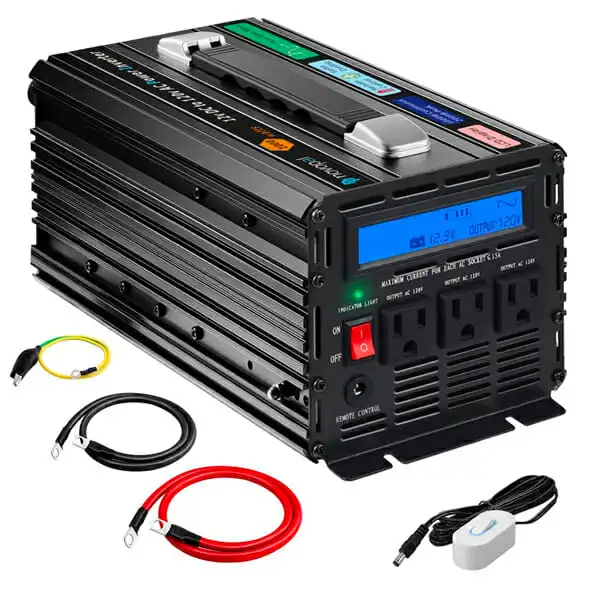
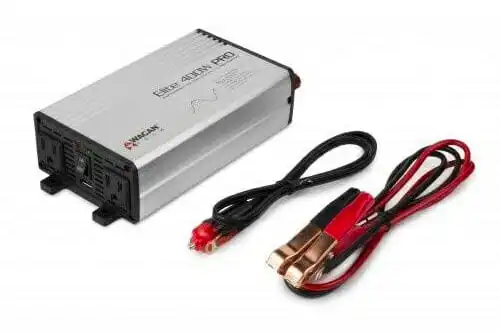
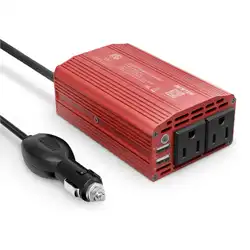
I didn’t know there were two types of converters. I’ll have to research MSW and PSW more. I’ve been thinking about making a large cross-country trip, so I might have to get a good converter.
Two of your recommended inverters are no longer available – maybe add a couple more? Super helpful article, btw!
Hey guys! Thank you for this. This post, and a lot of your site, has been so helpful for me while I work on my van build!
I’m currently at the electrical and wiring stage. The biggest priority I have in my setup is air conditioning off my LiPo battery bank. The AC i have has a running wattage of 580, so most likely has a starting demand of about 1740 watts. I have one 100Ah lipo battery, and will be adding on 6 more over the next year. But want to get everything hooked up now.
Before I read this article, I thought “great all I’ll do then is get a 1000 watt inverter with a surge rating of 2000 watts and I’ll be solid!”
But from what you’re saying, my expensive $1000 100Ah beast of a LiPo battery, I can only safely run a tiny 600 watt inverter?
Just want to make sure I got your saying right. I have seen 3 other builds where they’re successfully running their air conditioner off Lithium, but since this is my first build don’t want to fuck it up.
Thank youuuu!!!!!!!!!!!!!!!!!
Alex, Seriously. Need to use the F word?? That’s the only word that would express your thoughts? I guess I recall when I had my first hard cider.
The article is somewhat misleading: W vs. Amps. Read this article if you want to get a more accurate assessment of maximum power draw from a lithium battery: http://www.enerdrive.com.au/what-size-inverter/
Mike, apologies for the f bomb. “Mess it up” would have been sufficient.
Thank you for the article on inverters, that sounds like exactly what I need to read. Going to give it a deep read tonight after work.
Mike, I can only assume it was your first and last hard cider as you likely found the taste of alcohol offensive and unnecessary?
The way Alex used “fuck” does no harm to anyone except those with fragile sensibilities like yourself. You’re criticizing him for you using “fuck,” I’m criticizing your maturity for taking offense to it. Seriously, who fucking cares?
Also, thanks for sharing that article 🙂
its called courtesy. Sense you don’t know what that means here is the definition “The showing of politeness in ones attitude and behavior towards others. God Bless Semper Fi
Alex-
There are a couple of things for you to look at here. First off, the caveat of the article is that we’re writing to the lowest common denominator: Our rules of thumb are for quick “back of the napkin” sketching that will pretty much guarantee that you can’t go wrong. If you are looking to dive a little deeper, each battery and manufacturer will have different specifications to answer your questions. In looking at a 100Ah Battle Born battery, their manual states that they have a safe discharge rate of 100A (1200W) and a 30-second surge rate of 200A (2400W). Lithium batteries are also less sensitive to quick discharge, so you won’t be affecting the battery life as much as you will with one of the Lead-acid chemistries.
Ok, with that said, you’re planning on seven LFP batteries? That’s a massive, massive system. In fact, with a system that large you should not be using the standard 12V rules. You will not have good luck pairing seven batteries in parallel. To safely pair the batteries, you’ll need to size the connector wires to handle the combined load, and there aren’t any connectors that can handle 700A. As mentioned in the article listed by Mike, there are also balancing issues with doing something like this. Especially paralleling a used battery with new batteries (also a no-no for balancing issues). You’re in Tesla Powerwall territory (which I would look into at this point in your game). How are you planning on charging everything?
Ian, thank you, that is very helpful. After looking at the specs of my current battery, sounds like it can handle what I want to do, but probably have to go one up on the inverter. Which isn’t a bad thing as I want to get an inverter/charger instead anyway (which the next model up has).
Yes, 7 100ah Renogy LiPo batteries. That’s my plan right now anyway, but that’s about $7000, so it won’t be happening overnight. I imagine that’ll take me another 6-8 months to get it finished. You have given me other things to think with as well, balancing and wiring etc. I will be researching all that over the next months.
The Tesla Powerwall is pretty awesome. However this is for my van build and, well, don’t think a powerwall will work out too well on a van lol. Depending on the performance of my air conditioner, I might stop at 3, 4 or 5 batteries. We’ll see.
Charging comes from 4 sources: 400 watts of solar on the roof (usually enough for everything), main and secondary alternator (charging in transit and occasionally if needed when boondocking), little quiet honda or yamaha generator (might even not end up getting this if solar and alternators end up being plenty, but wanted to rig a switch that would turn this on automatically when batteries reach 15%) and shorepower (probably will rarely ever use, but why not have an inverter with the option).
Thanks again for the knowledge!!
Before you buy any batteries, head over to the experts solarpaneltalk.com and see what your best course of action is. Just adding batteries in parallel as your need arises is not as easy as it sounds. And you’re playing with household levels of power with that much LFP.
Some of the more conservative experts recommend not going above 1000W in a 12V system, because above that you’re playing with really high Amps. Plenty of people do so, but it gives you a starting point for managing you power needs. With that many batteries, I’d consider a 24V system.
Hi Alex! I’m in my build process currently and curious what type of air conditioner you have that you can run without a generator??? thank you!
Thanks for the info, your website is very well thought out and helpful. I’m in in midst of electrical planning and purchasing for our van set up and have a question about installing AC outlets that you might be able to answer. I have a 1000w Renogy inverter and was hoping to wire it to a couple AC sockets on each side of the van so that I could plug in a laptop or blender in convenient locations, rather than having to run the blender/laptop cord into the electrical box where the inverter will be. I don’t think Renogy recommends this and haven’t seen much info on how to do this elsewhere online. Curious what your thoughts are on this and what wires and fuses you would recommend for it. I should also mention is that the house battery will be powered by solar and the starter battery but we are not planning on installing shore power as we don’t tend to be in places to make use of that. Thanks in advance for your thoughts on this.
Senja:
I think what you are asking can be done, but I don’t think it is easy without having full electrical knowledge. There isn’t an easy way- you would need to make hardwired adapters and such. So, my default is to say that because your inverter doesn’t have connectors to be hardwired, then you shouldn’t be trying to use it in this way. What I would do instead is to just use some nice extension cords with wall-mounted power strips that can be placed under cabinet shelves or in the corners of your van. This way you’re using the inverter as it is intended and don’t need to deal with breakers or anything. Most large inverters have built in protection on the AC side so you don’t need to add any. Something like this or this would work for a fixed power strip.
Remember to turn your inverter off when you’re not using it. I think the 1000W Renogy one has a nice remote for this!
Hello,
Great article! Thank you very much.
I just started purchasing everything for my van conversion. So far I purchased two 100 watt Renogy solar with the 30A PWM charge controller. I also got two 125AH vmax batteries. Plan on charging my battery bank with the vans alternator as well. I am now searching for a good inverter to run basic van life needs. A fridge, laptop/camera/phone charging, small blender and may be a small tv to watch a movie now and then. I do not want to drain my battery with a huge inverter. And was wondering, base off experience, if you think my choice should be a 600w-800w inverter?
Also, do you think two 100W solar panels as well as hooking up my two batteries to my alternator with a Isolator will be able to fully charge my two 125AH batteries?
Thank you very much for the feed back. It is appreciated.
Hey! I purchased the Wagan 400W Pure Sine Inverter and am currently stumped on how to connect it to the house batteries for my van. I have the house batteries and solar panels all hooked up to the charge controller. But the terminals on the wires running from the house batteries are too big for the inverter. How do I connect the house batteries to this inverter?
Julia- you can replace the terminals on the house battery wires with new ones that fit your inverter. It’s probably easiest to go to your local auto parts store and buy a small pack of them. You can even bring in your inverter to make sure that they fit. You’re looking for something like this: https://amzn.to/2Xh6xcF but just in the size that you need. For this, you’ll need wire crimps/strippers.
Make sure that the positive wire is fused!
You guys hooking up these inverters you got to remember it takes a lot of juice to convert 12 volt 110 for every hundred wats you pull out of the inverter it takes 10 a so if you are pulling 500 wats 50 a 0ut of your battery your car takes about 50A to start so how long can you crank. Your car before the battery goes dead. Small tv and DVD player about 3 hrs on 4 100A batterys nead lots of amps
Hi Guys,
New to wiring and I am building out a van. I am trying to size my wiring from the battery to the inverter. Am I calculating this correctly? I am getting a 600 Watt inverter so then the amperage flowing from the battery to the inverter will be 50amps right? 600 watts/ 12 volts = 50 amps? Or is there something I am missing as I am not an electrician. Thanks.
Erik;
You’ve got it! 50A is the number you should use when sizing your wiring and fuse for that run.
Hi All – I have a Novopal RS1500 inverter. Works fine, but once it got too hot and the thermal protection did its job and shut the unit off. After 15 minutes it had cooled enough to power back up. So far, so good. My questions concern the two cooling fans. 1. Are they always running when the unit is powered on? 2. Are they audible? 3. Are the fans short circuit protected by a fuse or link? 4. Are the fans replaceable if they have been damaged? Thanks for any assist. Steve